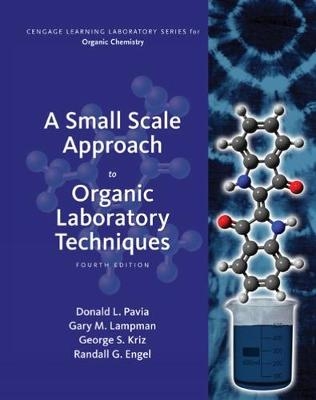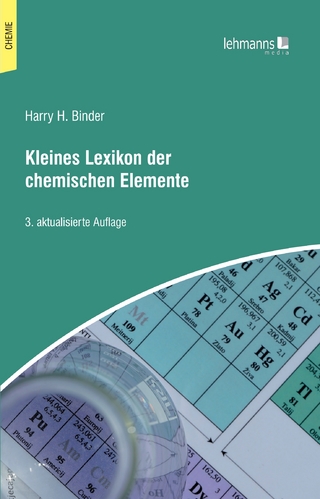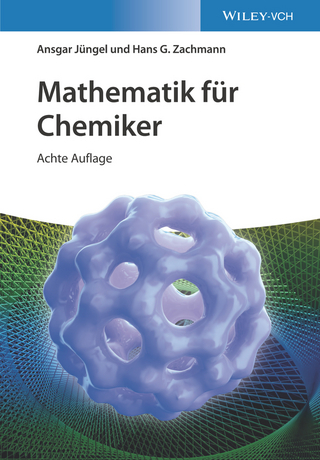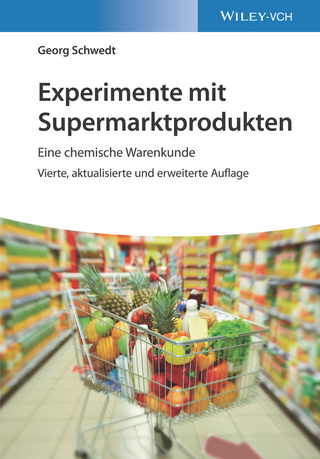
A Small Scale Approach to Organic Laboratory Techniques
Brooks/Cole (Verlag)
978-1-305-25392-6 (ISBN)
Donald L. Pavia earned his BS degree in chemistry from Reed College and his PhD in organic chemistry from Yale University. In 1970, he joined the faculty at Western Washington University as Assistant Professor and now holds the rank of Professor Emeritus. He is the coauthor of two organic laboratory books that include techniques and experiments: INTRODUCTION TO ORGANIC LABORATORY TECHNIQUES: A MICROSCALE APPROACH (Cengage Learning), and A SMALL SCALE APPROACH TO ORGANIC LABORATORY TECHNIQUES (Cengage Learning), as well as MICROSCALE AND MACROSCALE TECHNIQUES IN THE ORGANIC LABORATORY (Cengage Learning), which highlights techniques to be used with a faculty member's own experiments. He is a co-author, with Gary M. Lampman, George S. Kriz and James R. Vyvyan of an organic spectroscopy book, INTRODUCTION TO SPECTROSCOPY (Cengage Learning). Professor Pavia's research interests center on the synthesis and reactions of valence tautomeric and photochromic compounds, especially pyrylium-3-oxide tautomers. Autoxidations are a special interest. His other interests include the use of computers in teaching organic chemistry, both for lecture presentation and for the simulation of laboratories. He is the author of several computer programs. One such program is SQUALOR (Simulated Qualitative Organic Analysis) for which he won the 1986 EDUCOM/NCRIPTAL award. The program is designed for teaching the methods for solving organic unknowns. George S. Kriz is Professor of Chemistry at Western Washington University. He earned his B.S. degree in chemistry from the University of California, and his Ph.D. from Indiana University, Bloomington, IN. In 1967 he joined the faculty at Western Washington University and recently served as department chair. He served as the General Chair of the 17th Biennial Conference on Chemical Education for 2001-2002. Professor Kriz was honored with the Peter J. Elich Excellence in Teaching Award (College of Arts and Sciences), Western Washington University, in 2000 and the Distinguised Service Award from the Division of Chemical Education, American Chemical Society (2010). He is the co-author with Donald Pavia, Gary Lampman, and Randall Engel of two organic laboratory books that include both techniques and experiments: INTRODUCTION TO ORGANIC LABORATORY TECHNIQUES: A MICROSCALE APPROACH (Cengage Learning), and A SMALL SCALE APPROACH TO ORGANIC LABORATORY TECHNIQUES (Cengage Learning). Their book, MICROSCALE AND MACROSCALE TECHNIQUES IN THE ORGANIC LABORATORY (Cengage Learning), includes techniques only, and can be used with a faculty member's own experiments. He is a co-author, with Donald Pavia, Gary Lampman, and James Vyvyan, of an organic spectroscopy book, INTRODUCTION TO SPECTROSCOPY (Cengage Learning). Professor Kriz's research interests include: developing new experiments for the organic chemistry laboratory; chemical education and the teaching of chemistry courses for general-understanding audiences; and determination of the structures of natural products using spectroscopic methods. Gary M. Lampman earned his BS degree in chemistry from the University of California, Los Angeles, and his PhD in organic chemistry from the University of Washington. In 1964, he joined the faculty at Western Washington University as Assistant Professor, rising to Professor in 1973. He received the Outstanding Teaching Award for the College of Arts and Sciences in 1976. He now holds the title of Professor Emeritus. Teaching has always been an important part of his life. Contact with students invigorates him. He is the coauthor of two organic laboratory books that include techniques and experiments: INTRODUCTION TO ORGANIC LABORATORY TECHNIQUES: A MICROSCALE APPROACH (Cengage Learning), and A SMALL SCALE ARPPROACH TO ORGANIC LABORATORY TECHNIQUES (Cengage Learning), as well as MICROSCALE AND MACROSCALE TECHNIQUES IN THE ORGANIC LABORATORY (Cengage Learning), which highlights techniques to be used with a faculty member's own experiments. He is a co-author, with Donald L. Pavia, George S. Kriz, and James R. Vyvyan of an organic spectroscopy book, INTRODUCTION TO SPECTROSCOPY, Fourth Edition (Cengage Learning). Professor Lampman also is the author of the computer program for teaching organic nomenclature: ORGANIC NOMENCLATURE: AN INTRODUCTION TO THE IUPAC SYSTEM. His research interests center on synthetic methods involving the reaction of free radicals on unsaturated cobaloximes (vitamin B12 model compounds), synthesis of strained small ring compounds, and chemical education. He is the author of 18 papers in these areas. He is a member of the American Chemical Society (Organic and Chemical Education divisions), and the Washington College Chemistry Teachers Association. Randall G. Engel has taught chemistry for almost 35 years. He has co-authored with Donald Pavia, Gary Lampman, and George Kriz INTRODUCTION TO ORGANIC LABORATORY TECHNIQUES: A MICROSCALE APPROACH (Cengage Learning), and A SMALL SCALE INTRODUCTION TO ORGANIC LABORATORY TECHNIQUES (Cengage Learning). Their book, MICROSCALE AND MACROSCALE TECHNIQUES IN THE ORGANIC LABORATORY (Cengage Learning), includes techniques only, and can be used with a faculty member's own experiments. Engel received his B.A. degree in chemistry from Cornell College and his M.S. degree in chemistry from Western Washington University. He began his teaching career at Wenatchee Valley College in 1975 and continued at Green River Community College and Edmonds Community College. Presently he teaches organic chemistry on a part-time basis at North Seattle Community College.
Introduction.
WELCOME TO ORGANIC CHEMISTRY.
Laboratory Safety. Organization of the Textbook. Advance Preparation. Budgeting Time. Purpose.
PART I: INTRODUCTION TO BASIC LABORATORY TECHNIQUES.
Experiment 1. Solubility.
Experiment 2. Crystallization.
Experiment 3. Extraction.
Experiment 4. A Separation and Purification Scheme.
Experiment 4A. Extractions with a Separatory Funnel.
Experiment 4B. Extractions with a Screw-Cap Centrifuge Tube
Experiment 5. Chromatography.
Experiment 5A. Thin-Layer Chromatography.
Experiment 5B. Selecting the Correct Solvent for Thin-Layer Chromatography.
Experiment 5C. Monitoring a Reaction with Thin Layer Chromatography.
Experiment 5D. Column Chromatography.
Experiment 6. Simple and Fractional Distillation
Experiment 7. Infrared Spectroscopy and Boiling-Point Determination
Essay. Aspirin.
Experiment 8. Acetylsalicylic Acid.
Essay. Analgesics.
Experiment 9. Acetaminophen.
Essay. Identification of Drugs.
Experiment 10.TLC Analysis of Analgesic Drugs.
Essay. Caffeine.
Experiment 11. Isolation of Caffeine.
Experiment 11A. Extraction of Caffeine from Tea.
Experiment 11B. Isolation of Caffeine from a Tea Bag.
Essay. Esters--Flavors and Fragrances.
Experiment 12: Isopentyl Acetate (Banana Oil).
Essay, Terpenes and Phenylpropanoids.
Experiment 13. Isolation of Eugenol from Cloves.
Essay. Stereochemical Theory of Odor.
Experiment 14. Spearmint and Caraway Oil: (+)- and (-)- Carvones.
Essay.The Chemistry of Vision.
Experiment 15. Isolation of Chlorophyll and Carotenoid Pigments from Spinach.
Essay: Ethanol and Fermentation Chemistry.
Experiment 16. Ethanol from Sucrose.
PART II: INTRODUCTION TO MOLECULAR MODELING.
Essay: Molecular Modeling and Molecular Mechanics.
Experiment 17. An Introduction to Molecular Modeling.
Experiment 17A. The Conformations of n-Butane: Local Minima.
Experiment 17B. Cyclohexane Chair and Boat Conformations.
Experiment 17C. Substituted Cyclohexane Rings (Critical Thinking Exercise).
Experiment 17D. cis- and trans-2-Butene.
Essay: Computational Chemistry - Ab initio and Semiempirical Methods.
Experiment 18. Computational Chemistry.
Experiment 18A. Heats of Formation: Isomerism, Tautomerism, and Regioselectivity.
Experiment 18B. Heats of Reactions: SN1 Reaction Rates.
Experiment 18C. Density-Electrostatic Potential. Maps: Acidities of Carboxylic Acids.
Experiment 18D. Density -Electrostatic Potential Maps: Carbocations.
Experiment 18E. Density -LUMO Maps: Reactivities of Carbonyl Groups.
PART III: PREPARATIONS AND REACTIONS OF ORGANIC COMPOUNDS.
Experiment 19. Reactivities of Some Alkyl Halides.
Experiment 20. Nucleophilic Substitution Reactions: Competing Nucleophiles
Experiment 20A. Competing Nucleophiles with 1-Butanol or 2-Butanol.
Experiment 20B. Competing Nucleophiles with 2-Methyl-2-Propanol.
Experiment 20C. Analysis.
Experiment 21. Synthesis of n-Butyl Bromide and t-Pentyl Chloride.
Experiment 21A. n-Butyl Bromide.
Experiment 21B. t-Pentyl Chloride.
Experiment 22. 4-Methylcyclohexen
Essay. Fats and Oils.
Experiment 23. Methyl Stearate from Methyl Oleate.
Essay: Soap
Experiment 24. Preparation of Soap.
Essay: Petroleum and Fossil Fuels.
Experiment 25. Gas Chromatographic Analysis of Gasolines.
Essay: Biofuels.
Experiment 26. Biodiesel.
Experiment 26A. Biodiesel from Coconut Oil.
Experiment 26B. Biodiesel from Other Oils.
Experiment 26C. Analysis of Biodiesel.
Essay: Green Chemistry.
Experiment 27. Chiral Reduction of Ethyl Acetoacetate; Optical Purity Determination.
Experiment 27A. Chiral Reduction of Ethyl Acetoacetate.
Experiment 27B. NMR Determination of the Optical Purity of Ethyl (S)-3-Hydroxybutanoate.
Experiment 28. Nitration of Aromatic Compounds Using a Recyclable Catalyst.
Experiment 29. Reduction of Ketones Using Carrots as Biological Reducing Agents
Experiment 30. Resolution of (+/-)-alpha-Phenylethylamine and Determination of Optical Purity.
Experiment 30A. Resolution of (+/-)-alpha-Phenylethylamine.
Experiment 30B. Determination of Optical Purity Using NMR and a Ch
| Verlagsort | CA |
|---|---|
| Sprache | englisch |
| Maße | 224 x 41 mm |
| Gewicht | 2155 g |
| Themenwelt | Naturwissenschaften ► Chemie ► Allgemeines / Lexika |
| Naturwissenschaften ► Chemie ► Organische Chemie | |
| Sozialwissenschaften ► Pädagogik | |
| ISBN-10 | 1-305-25392-2 / 1305253922 |
| ISBN-13 | 978-1-305-25392-6 / 9781305253926 |
| Zustand | Neuware |
| Haben Sie eine Frage zum Produkt? |
aus dem Bereich


